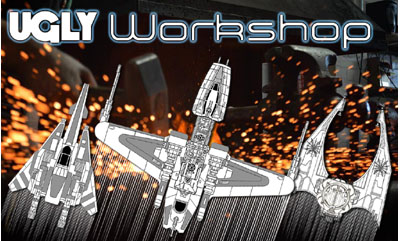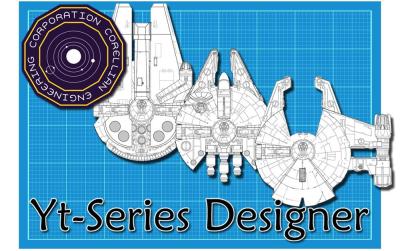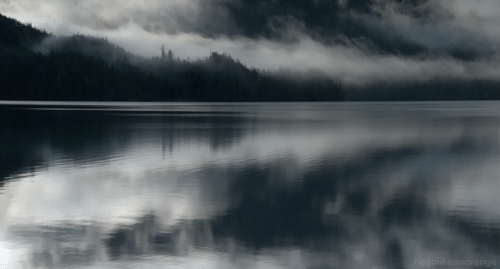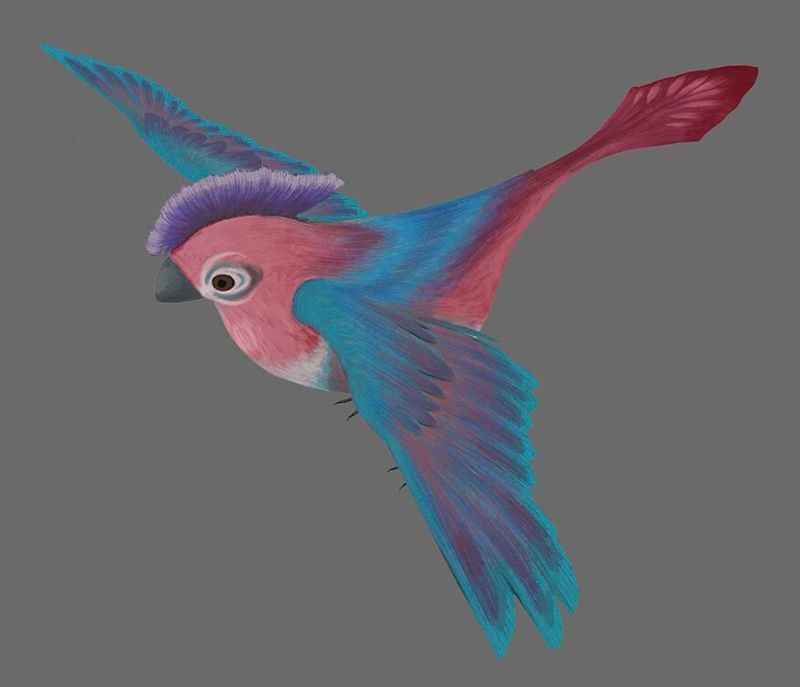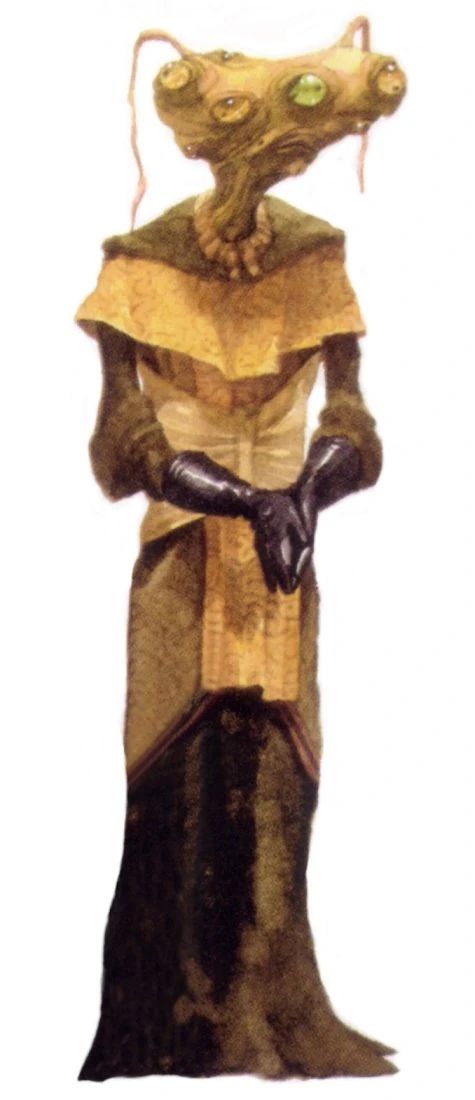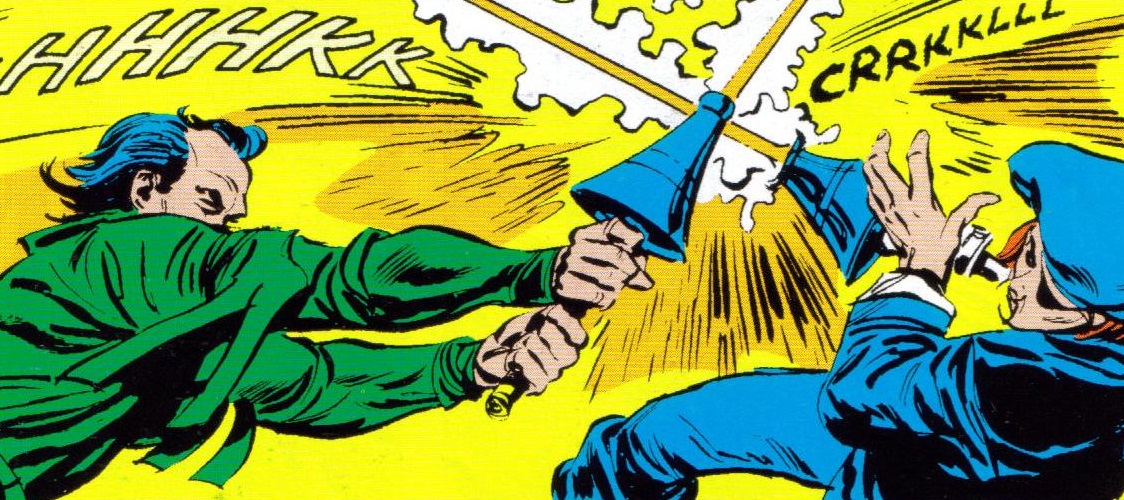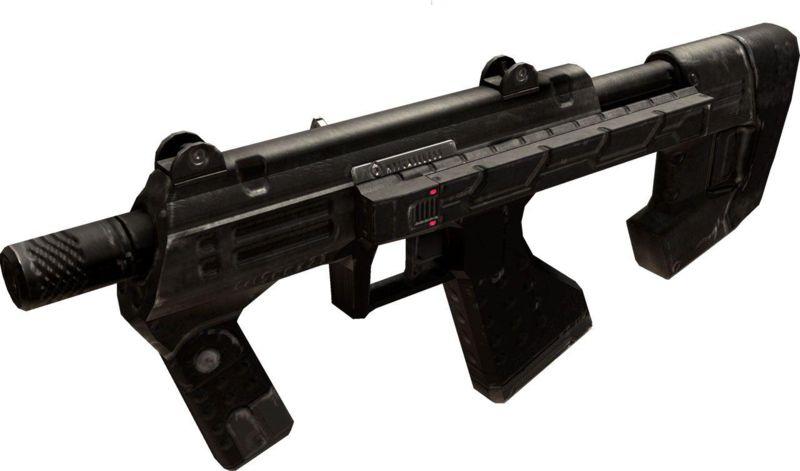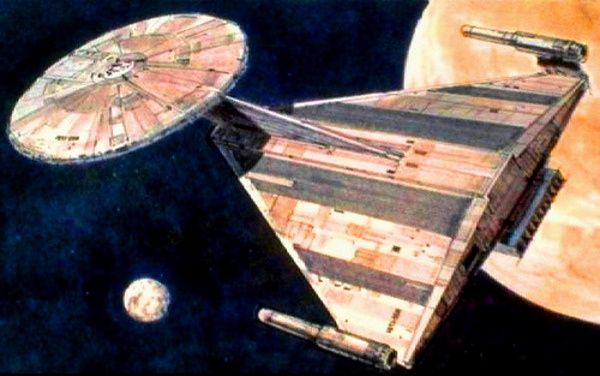 MCQUARRIE CLASS DEEP SPACE EXPLORER
"The best part of the whole design was that the lower hull had a wedge shape like many KDY ships, and the upper hull had a circular shape like many CEC ships...the best offensive gesture USC could have done to the corporations who fired them several years ago. And their future customers seemed to agree as well."
-A happy customer.
Craft: McQuarrie class deep space explorer
Model: Unity Stardrive Corp McQuarrie class deep space explorer
Affiliation: Galactic Republic (and many others)
Type: Exploration vessel
Scale: Capital
Dimensions:
-Length: 210m
Skill: Capital ship piloting (McQuarrie class)
Crew: 154
-Gunners: 28
-Skeleton: 50/+10
-Emergency Evac: 2,000+
Crew Skill: Capital ship gunnery 5D, capital ship piloting 5D+2, capital ship shields 4D+2, sensors 6D, starship gunnery 5D+1
Passengers: 200 (science staff)
Cargo Capacity: 50,000 metric tons
Consumables: 2 years
Cost: 14,450,000 (new); 9,500,000 (used)
Hyperdrive Multiplier: x2
Hyperdrive Backup: x18
Nav Computer: Yes
Maneuverability: 3D
Speed:
-Space: 4
-Atmosphere: 280; 800kmh
Hull: 4D
Defenses:
-Shields: 2D
Sensors:
-Passive: 20/1D
-Scan: 40/1D+2
-Search: 80/2D
-Focus: 3/3D
CRAFT CAPACITY:
-6 Starfighters or Light Shuttles
-2 Transport Shuttles
-4 Worker Pods
WEAPONS:
12 Laser Cannons
Location: Mounted on dorsal and ventral upper hull
Fire Arc: Turret
Crew: 1 (12)
Skill: Starship gunnery
Scale: Starfighter
Fire Control: 2D
Range:
-Space: 1-3/12/25
-Atmosphere: 100-300/1.2/2.5km
Damage: 2D
Rate Of Fire: 1
4 Concussion Missile Launchers
Location: Mounted in front sides of lower hull
Fire Arc: Front
Crew: 4 (4)
Skill: Capital ship gunnery
Scale: Capital
Fire Control: 3D
Range:
-Space: 2-10/25/50
-Atmosphere: 200-1/2.5/5km
Damage: 7D
Ammo: 10 each (40 total)
Rate Of Fire: 1
Special: Ion, anti-shield plasma, and other variants potentially available (see below)
Tractor Beam
Location: Mounted in aft hull near shuttle bay
Fire Arc: Back
Crew: 1
Skill: Capital ship gunnery
Scale: Capital
Fire Control: 3D
Range:
-Space: 1-3/10/20
-Atmosphere: 100-300/1/2km
Damage: 4D
Rate Of Fire: 1
DESCRIPTION:
The McQuarrie class deep space explorer was a revolutionary starship designed and sold around 400 BBY. During a time if galactic recession, starships, as well as many other products, failed to make profit, which led to a shift in the galactic status quo. When the McQuarrie class hit the market, it was originally a multi-purpose cargo vessel that was very durable and long-lasting. It could easily be outfitted for other roles, or refitted later after construction to fill a different purpose. As the recession lefted, this gave way to a new era of exploration for varied reasons, which led to the McQuarrie class most commonly being sold as a deep space exploration ship.
As time would pass, the McQuarrie class would eventually fall out of favor as an exploration ship as this time of exploration eventually subsided to a more practical age of necessity. The McQuarrie class would find a much more long-lived place in the market for several centuries as the multi-purpose cargo vessel it was originally intended as, though many organizations and groups would still use the ship refitted as anything and everything from a yacht, a scout, an armed escort or some other fill-in for a business or military needing more ships. Many pirate and freedom fighter forces also found excellent use for the ship long after it was released as new on the open market.
LAYOUT
-Labs, Workstations, and other Facilities: The McQuarrie class deep space explorers are menat for long term distance and travel. To this end, they have consumables for up to two years, and much of their cargo space has been converted not only for passengers and their personal and scientific gear, but also many well stocked and equipped laboratories and technical workstations to allow them to do their research. Sometimes these labs have more than one scientist or technician making use of them for multiple projects, as this is still a starship with only so much available space to make use of. These labs can do be used for almost any project, from xenozoology, microbiology, chemical and chemistry, stellar cartography, and various levels of quantum physics and astrophysics, among many others. These labs can also be converted and repurposed as desired. The other workstations are often for technicians that are not devoted scietists but engineers and techies who deal more with the hardware, franging from physical labor with large machines and devices, labor with smaller, more fine-tuned and detailed machines, computer techs involved with both hardware and software, and even materials fabrication of practically any kind needed during long exploration missions using particle fabricator machines whose ancestors harkon back to devices once called "3D printers". The particle fabricators are one of the must unsung yet important parts of the ship, as they can produce not only materials, but also specific shapes, of various sizes oncluding very large sizes, can combine multiple materials to make various types of compounds, and is essential for making any and all replacement parts the ship would ever need. There are several types of particle fabricators on board, most used for parts and components, though some have been set aside for producing common materials like clothes, and for producing foodstuffs. The food version is used rarely as the food is often criticized as not being as good as the real thing (though most foods in the Star Wars galaxy are probably synthetic anyway), however these are still aboard the ships due to the potential of stored consumables becoming corrupted through any number of possible means, and make a welcome alternative of food if and when the crew gets hungry enough. As these are called "particle fabricators", they can use raw materials of almost any kind to produce results, though the more work they have to put in converting raw materials into something else, the longer and harder they will have to work. For instance, using metal to produce other metals is relatively simple and takes little time, but taking raw ores and converting them takes more time, and taking non-metallic materials and converting them to produce metals could take over a day at best for simoke items, and many days for larger items, if they are kept simple like wrenches or hull plating. One reason the food fabricators are not used, aside form taste, is that the best raw materials used in them should be materials already used for foodstuffs, such as discard food remnants and other waste, though the fabricator eliminates any form of contamination, and in fact can take any contamination in these wastes and completely convert it into an edible foodstuff in the process. It should also be noted that the fabricators deliver priduct and item results as good as the designs used in their computers, which can and usually is done by a technician who specializes in such design elements. Unfortunately, while food fabricators also work this way, there are rarely any technicians aboard who know how to "design food" and the food fabricators are left to use default factory installed food designs that are often bland at best. All of these facilities, computers, machinery, and various other equipemnt in both labs and storage are taken account in how much cargo space is taken up in the conversion of the McQuarrie class into an exploration vessel. The science and exploration labs tend to be displaced throughout the upper hull saucer section, while the techinical and engineering workstations tend to be in the lower hull section.
-Shuttle Bay: The ship's shuttle bay is located in the aft of the lower hull. Though this is positioned between the ship's ion engines, the vessel's design and the common sense of any decent pilot is such that approach, embarking and disembarking is an easy and smooth process with very little danger. While the "craft capacity" above lists 6 starfighters or light shuttles, most often these explorer vessels have various craft that can carry 1-2 or 1-4 passengers that are roughly the size of a starfighter, built less for combat with little-to-no weapons, but having better sensors than most starfighters their size usually would, though they may have comparative speed diue to the need to evade hostile threats and environments. These can be used to expand the ship's sensor detecting capabilities, as well as allowing for closer inspection of odd things found in space, and even performing reconnaisance of derelicts in space or planetary atmospheres and geography. The listed 2 transport shuttles are craft usually bigger than starfighters that can carry 1-12 passengers, long term away gear, various scientific equipment depending on mission and need, and perhaps even a light ground vehicle (1-4 oassengers) or 2 (speeder bikes), and are often meant for investigation and exploration teams that are leaving the ship and heading to the ground of a planet or into a derelict ship or space station, etc, and are intended for investigation and exploration teams that will be away for prolonged periods of time...."away teams".
GAME NOTES:
-S-Foil Pylons and Add-On Pods: While odd looking in the ship design, these additions to the hull increase the ship's overall speed, maneuverability, sensors, and shields. When these are damaged and destroyed, their removal decreases these traits and affects the ship's performance. The loss of a pod decreases Speed -1, Shields -1 pip, and Sensors decrease -5 Passive range, -10 Scan and Search ranges, -1 Focus Range, and -1 pip to bonus dice. The loss of an S-Foil pylon that these pods are mounted on decreases the ship's maneuverability by -1D. The loss of both pods and both S-Foil pylons reduces the ship's Speed to 2, Maneuverability to 1D, Shields to 1D+1, and Sensors to Passive: 10/+1, Scan: 20/1D, Search: 60/1D+1, Focus: 1/2D+1.
-Sensor Dish Add-On (1,000,000 credits): As the Deep Space Explorer is a variant of the original general purpose McQuarrie class that includes what were intended as after-market upgrades, this version is known to have firther upgrades to enhance the ship's abilities. One add-on is an expansion to the sensors in the form of a sensors and communications dish, often mounted at the central front of the wedge-shaped lower hull. This add-on costs 1,000,000 credits, and enhances the Sensors as +5 Passive range, +10 Scan range, +20 Search range, +1 Focus range, and +1 pip to the Sensor bonus dice. As this variant is meant for deep space exploration, most ship owners who can afford this upgrade usually purchase it as soon as they are able, though many owners do not, and many others who use their McQuarrie class ships for shipping lane travel actually prefer not to have ot, as it makes their ship look more like the original cargo vessel the ship class was intended as, therefor luring pirates into a fight only to be surprised by the ship's impressive firepower and combat abilities.
-Concussion Missile Variants And Other Mods: While the McQuarrie explorer variant has weapons like laser cannons and missile launchers installed to defend itself against enemies and hostile threats that lie in the great unknown, often these weapons were used in uninteded yet strangely beneficial ways. Many crews of these ships were lucky to possess individuals who were gifted with technical aptitude as well as imagination and creativity. When the ships and their crews found themselves trapped in situations where they could not escape with brute force, these individuals would often have ideas that involved modifying equipment and weapons aboard the explorer vessels to gain the upper hand and survive against all odds. In the case of the cincussion missile launchers, the missile warheads would often be altered or replaced to deliver entirely different effects than what they were designed for. In 400 BBY, weapons like ion bombs and plasma torpedoes were not always common, and scientists and technicians aboard these vessels would use the scientific and technological equipment aboard their well stocked and equipped exploration and science vessels to modify various concussion missile to act as power disabling ion missiles or shield-specific busting warheads. While these make great examples of what can be achieved with a well sticked and equipped science and exploration vessel with a creative crew, often the sky is the limit with what can be achieved when the right toold and resources are available.
-Neck Hull Section: Though the neck section linking the upper and lower hulls is surprisingly strong for the purpose it serves due to Arkanian design epertise, it is still weaker than the larger sections of hull. If any attackers ever succeed at a called shot attack on the neck section, the Hull dice here will be -1D.
GAME DESIGN NOTES:
Anyone who knows their scifi lore knows where the pic and name of this ship comes from, but in case you don't....the McQuarrie class here is inspired by the concept art by Ralph McQuarrie when he did pre-production concept work on what would have been Star Trek Phase 2 in the 1970s. The intended televison follow-up series was never produced, with some of its concepts being used later in the movie Star Trek The Motion Picture, though not the ship design. Ralph McQuarrie himself went on to work on the movie Star Wars itself, creating many of the most famous starship designs that scifi fans would frecognoze anywhere. And because of that, I wanted to add this ship into Star Wars, even if it's only as a fan work.
When trying to figure out stats for the ship, at first I was interested in using the Nebulon-B Escort Frigate as inspiration and feference material. But as I was looking for stats on Concussion missile launchers, I came across the Star Galleon and Dreadnought in the Imperial Sourcebook. As the Star Galleon was closer in size and armament, and the Dreadnought was an older ship the predates the Clone Wars and still saw service like the McQuarrie class is intended to be here, these became the reference material that inspired the stats for this ship.
As the Star Galleon was the main inspiration for size, by comparison the Star Galleon looks almost like a brick, a little tall but somewhat thin, and is 300 meters long. The McQuarrie class is 210 meters long which at first would seem like it would have less cargo spce, until you compare the height/depth and width. The McQuarrie is much, MUCH wider than the Star Galleon, and the original cargo vessel version had an abundance of cargo space in both the upper and lower hull sections before being converted into a deep space explorer. Furthermore, the Star Galleon's hull is not fully devoted to cargo space, as it has good shields and weapons, as well as the cargo hold being a secondary ship in and of itself that can separate from the ship, fly off, and even jump to Hyperspace. Because of this, a shorter but wider ship intended as a cargo vessel before alterations could have 100,000 metric tons of cargo space. The deep space explorer presented here has less than this, but this is due to add-ons, upgrades and refits that altered the original cargo vessel into the deep space explorer variant. If these were removed, the original 100,000 metric tons of space could be regained. Currently, the space taken up by the deep space explorer variant involved the laser cannons, concussion missile launchers, stronger sensors, and cargo space converted to allow for passengers in the form of scientists, technicians and other exploration-based staff, as well as extra facilities like labs and work stations for them to perform their work in. It should also be mentioned that the addition of the S-Foil Pylons and Add-On Pods allow for modifications to be done externally without taking up further cargo space inside the ship.
HISTORY
What follows is a history not only of the McQuarrie class vessel, but also if Unity Stardrive Corp who built it, and the state of the galaxy that led to this ship's creation...
The Galactic Recession.
Around 400 BBY, several well known starship manufacturers, especially Corellian Engineering Corporation and Kuat Drive Yards, as well as their subsidiaries, went through a phase of downsizing. This was due to many factors culminating in a galaxy wide temporary recession. While the Galactic Republic worked to address these issues for many decades, employees at all levels of these businesses were let go, sometimes even without their oensions and retirement savings, and had to find other ways to make their living in a galaxy that at the time did not have use for their specific skill sets.
As a result, several individuals with their own ambitions and the connections to make them a reality came together and formed their own starship manufacturing business, known as Unity Stardrive Corporation (USC). To distance themselves from the Core World based ship manufacturers that had let them go in the first place, this shipwright start-up based itself in the Colonies region of the galaxy, on the world of Ventis, in the Ko'lamiig system of space sector Lomiig.
Establishment of Unity Stardrive Corp.
This area was chosen for several reasons. For starters, the people of Ventis were close to a well established Hyperspace trade route that saw extensive traffic between the Core Worlds and the Outer Rim, with several nearby star systems with already well established resupply and trade businesses making use of this traffic. Second, the people Ventis were hungry to take part in this trade business, but so far had not been able to break into the markets along the trade route without going through the larger corporations that already had a presence. This would take away from Ventis' economy instead of improving it. And third, Ventis had suffered an economic slump in recent centuries as it had once been a luxurious colony world with beautiful lands and comfortably spacious orbital cylindar habitats to live in for the wealthy. After a disaster 200+ years prior where one of these orbital habitats was destroyed and all lives aboard were lost, people began to leave the habitats. As other nearby worlds were establishing their presence along the trade route while Ventis was losing its luxuirous appeal, people began leaving the surface of the world as well to seek their fortunes elsewhere. The result was an economic crash that Ventis never recovered from as the native humans of the once flourishing colony had more reasons to leave than stay. As a result, Ventis has many abandoned habitats in orbit that have not been used in over a century. Though these also lack proper maintenance and would take years to make useable again, this also meant these older structures could easilt be converted into orbital shipyards. It was easier to convert and improve what was already there, than build new shipyards from scratch. And THIS is why Ventis was perfect to become the headquarters of the newly established Unity Stardrive Corp.
Ventis' potential as a shipyard had been known for some time by a USC founding member who had once worked for KDY named Ralph McQuarrie. McQuarrie had kept this information to themselves awaiting a time when presenting such an easy acquisition would help propel their career. But when their job was suddenly on the chopping block with no chance of reversing the decision, McQuarrie quietly took this information with them when they left KDY, using it as a means to secure their place among the founders of USC, but also to give the fledgling shipwright start-up and fighting chance for success.
The USC founders approached the government of Ventis and proposed their plans to the lead officials. If USC was going to operate in such a large capacity as manufacturing starships and challenge the more long-lived shipwrights of the galaxy, they were going to need every advantage and ally they could get. And it would make things easier to have the very world they intended to operate from working with them than against them. Lucky, Ventis appetite for an economic boom was ravishing, and the planet's government was behind USC's business venture completely.
The rest was relatively simple. The founders took secrets of KDY and CEC and sold these to other interested parties. It didn't matter who they sold the information to as long as they paid enough for it. This had two results. Firstly, these secrets were so improtant that other shipwright businesses and other parties on the Black Market paid so much in credits that USC had more than enough venture capital to begin orbital construction at Ventis and repurpose the cylinder habitats. Second, the information sold would throw KDY and CEC into so much chaos for years to come that they would have other things to worry about than harass a fledgling upstart business.
Along with preparing the shipyards, USC began reaching out and making the connections needed to make the business run and thrive. Companies involved with mining and the trade of raw resources, refining those resources, and establishing departments for sales and logistics. When needed, USC outsourced when there were no other options, but with the goal of making everything as in-house as possible down the road. As there were many other ex-employees of KDY and CEC, these people received Holonet messages offering jobs to come and work for Unity Stardrive Corp. USC unsurprisingly had an already established workforce ready and willing to make the move to Ventis with their families, eager to get back to work.
The only thing left at this point was to find a market willing to buy starships during a time when the galaxy was experiencing a recession. Thankfully, many USC founders had information on various issues that were part of the cause of the recession, and while many of these were being taken care of by the Galactic Republic, several other issues had been dealt with due to the fact that KDY, CEC, and several other galaxy scaled businesses had been fanning flames on these issues to make them worse and profit from the ensuing strife. Thankfully, this had slowed down as these corporations were still dealing with the fallout of their leaks and would probably be doing so for years, if not decades to come. All in all, when KDY and CEC began letting people go, it became a power struggle, and many of the wrong individuals were pushed out, only for this to hurt these businesses later as they were the smart ones who could have found ways to keep them going and return them to better days if given the chance. Instead, these individuals decided to build their own success elsewhere at CEC's and KDY's expense in retaliation for such treatment.
Seeking The Best Advantages In A Harsh Galaxy.
With everything that was coming together for USC, it still wasn't enough. With all these efforts in play, upon officially opening and taking orders, USC was still going to be a small business in the galactic scheme of things, and could easily be rolled over when the larger corporations finally realized that a rival had arisen from the galactic recession. To fill these gaps and expand to a more challenging size and have a stronger presence when they launched, USC reached out to several starship technology companies, the kind you go to for after-market parts, modifications, customizations, and upgrades, and began negotiations to offer their products and services at the Ventis orbital shipyards to customers. This allowed USC to not only break into the shipbuilding business, but to do work on the already existing ships of paying customers as well.
While the founders and their assitants and business scouts were looking into this, they made a few discoveries. The shipyards at Sluis Van had also not faired well during the galactic recession and subsequently let go of many of their shipwrights as well, not due to a power struggle but out of necessity. USC hired many of the Sluisii techs and altered their plans for part of the orbital facilities to offer maintenance services on par with Sluis Van, who were known for taking longer with their work but delivering top level results that no one could compare to....until now that is.
And a final break for USC in their search for every advantage they could find came in the form of, surprisingly, Hoersch-Kessel Driveworks, Inc.(HKD). HKD had had many setbacks in recent decades as a competitor of KDY and CEC. To further complicate matters, HKD was a subsidiary of the Trade Federation, CEC was a subsidiary of the Techno Union, and KDY had always been powerful in their own right as they had deep connections to The Ten and the Core Worlds. These deeper connections had a great deal to to with the recession on the galactic scale of things, and overall HKD and the Trade Federation were currently on the worse end of things, but looking for ways to recoup and improve their situation while KDY and CEC were experiencing "techncal difficulties" for the time being.
It also came to light that some of the information the USC founders sold to make their start-up capital had wound up in HKD hands. With all of this coming to light, USC contacted individuals who could relay messages and information past the official policy of not accepting unsolicited business offers. This made HKD aware that their facilities could be available for outsourcing if desired. HKD did not ommediately offer a reply, but this wuld change in time.
And so United Stardrive Corp was born. Now all they needed was a ship to sell...
Looking For A Market.
In the following years, Ventis underwent many renovations on the surface and in orbit in preparation for USC's "grand opening". While all of this was under development, USC founders gathered the best designers and technicians they could find who had been fired during the recession, or whom they could lure away from future competitors with profits and promises (that they would keep in order to establish trust and not be like their predecessors, which worked). This design team then began working alongside the founders to decide what their first sellable ship design would be. As things had slowly began falling into place over the past two years of preparation and development for their business, USC personnel had also been seeking markets while deciding what kind of ship to make. War ships for the time being were out of the question as military and law enforcement organizations, while always looking to spend their budgets on something, already had well established connections with the longer-lived ship manufacturers of the galaxy. Also, building military vessels involved a lot of red tape with the Galactic Republic, and since this involved dealing with the Core Worlds, where CEC and KDY were firmly entrenched, this was best left alone for the time being.
What USC needed for their first ship had to be something widely available and desirable for everyone, both civilians and businesses looking for something new.
When making connections for gathering the resources and materials to begin constructing starships, USC realized that many trade businesses making the run between the Outer Rim and the Core were using outdated ships of all kinds. Many of these ships were barely holding together with the resources needed to maintain, upgrade or refit them only being available more towards the Core Worlds once they got past the Colonies region, but only rarely and sparsly available further out towards the Inner, Mid, and Outer Rim regions, with their only luck often being in the Expansion region where prices were far to expensive. And this was probably, yet again, due to the galactic resession.
So, after making connections for resources and materials, USC began approaching mining and trade businesses about services for maintenance, upgrades, or potential ship replacements. Many of these businesses had a wide range of desires in what they were looking for, and in the end it all depended on regional availability and cost.
This sparked several brainstorms that sparked a fire for USC's first ship design. All of this culminated in the decison to make a ship that would begin as a cargo vessel, updated to modern standards but designed to keep costs low by offering a "base model". This base model could then be upgraded through products and services offered by the many connections USC had established with many other companies that offered various starship technologies. Through these connections, Ventis became the closest location to the Outer Rim that now offered these services, as KDY and CEC had consolidated their business presence away from the galactic rim during this time, and HKD operated in other parts of the galaxy.
With this, the design phase finally took off in leaps and bounds.
Designing The Ship.
With things moving forward, Ralph McQuarrie, once a designer who moved up the corporate ladder until he was let go from KDY, had had enough of the corporate backstabbing and subterfuge, and made a life decision to go back to what he was good at amd loved to do at heart: designing great starships. While leaving the intrigues of business to the more interested founders of USC, he joined the design team and put his heart and soul into the new ship USC would produce.
As the design team began work, one expert in various technologies, and Arkanian named Vagran Hethaar sparked a rivalry with McQuarrie. While Ralph wanted the design to be practical, Vagran wanted the new ship to be state-of-the-art, "a ship that any Arkanian would be proud to own and fly". This rivalry risked delaying the entire production of the new ship, and everyone else on the design team thought briefly that this could ruin the ebtire project.
The two would quickly come to terms however, as Ralph was old enough to be well past such in-fighting, and Vagran learned from watching members of his own kind and from Arkanian history that letting arrogance get the better of him probably wouldn't work out so well. The two sat down over drinks and made many compromises that, in hindsight, were very simple and would exemplify what USC was trying to stand for in the first place, concessions that would only enhance the business as a whole.
The simple yet durable and multi-role model of the new ship would go through as the base model, while Vagrans design ideas would be implemented as upgrades available for extra charge as desired. But the base model ship had to come first, and it had to sell well, if the new company was going to have any chance of success.
As the next several months passed and the finishing touches were being put on the design, the marketing department was given the order to take CG models of the new design and begin building the hype for it accross select marketing areas through the Holonet, while all previously contacted businesses who showed interest were sent infologs detailing the new ship.
The marketing campaign showed off the features of the ship, details about its capabilities and uses, and emphasized how the ship could be outfitted for anything the mind could imagine. When Ralph finally saw the ad campaign himself, he was surprised that the ship was named the McQuarrie class. He had left the naming of the ship class up to the marketing department to decide a name that would help it sell. When he asked about this, it turned out that Vagran had been the one to siggest naming it after Ralph himself, and even more surprisingly, gave Ralph most of the credit. Truly, Vagran was not like most other Arkanians.
The final design of the McQuarrie class had not one main section of hull, but two, a lower hull that trailed towards the aft, and an upper hull that reach more forward. The lower hull had a somewhat wedged shape to it and housed the ship's main ion engines, while the upper hull was circular and had the ship's bridge in the top center. In between them was a "neck" section connecting the two hulls that looked weak at first glance but was deceptively strong for a ship of its size. This strength was in no small part due to Vagran's expertise in Arkanian design elements and technological know-how.
The ship had a vast amount of cargo space in both hull sections. This could be used as-is for cargo space to transport freight, materials, raw resources, etc, as desired, or be outfitted for handling specialized cargo either in sectioned off partisans or for the whole ship. If owners desired, space in the lower hull could be converted to expand the engines for more power and speed. Upper cargo space could be converted for more passenger room and boarding locks if used as a starliner or some other form of personnel transport. Both hull sections could be given extra shield generators or add weapons for better defense, as the original McQuarrie class did not have weapons.
The best part of the whole design was that the lower hull had a wedge shape like many KDY ships, and the upper hull had a circular shape like many CEC ships...the best offensive gesture USC could have done to the corporations who fired them several years ago. And their future customers seemed to agree as well.
When USC finally opened up to taking orders, the many businesses of the hyperspace lanes on this part of the galaxy flooded them with orders, for both the new upcoming McQuarrie class cargo vessel, as well as the many other services and ship technology products they could offer. Business boomed from the very beginning, because this part of the galaxy wanted it, and were in difre need of it.
This Is Not The Ship You Were Looking For.
After the first two months of selling the first batch of completed McQuarrie class vessels as cargo ships, a holovid began making the rounds across the Holonet. A McQuarrie cargo ship called the "Neutron Stormbird" had been purchased early on, but with an upgrade that had been designed by Vagran. The upgrade consisted of adding capital scale S-foil pylons on the aft corners of the lower hull that would improve overall maneuverability of the ship.
While this upgrade was thought to not be desirable when the ship became available for purchase due to it affecting the overall aesthetic of the ship ("who wants to buy an ugly ship?"), Vagran had gone even further by developing pods that could be attached to these S-foils. These pods could be modular and swapped out for various roles and could house additional ion engines for increased speed, extra thrusters for more maneuverability, shield generators for defense, cargo pods for yet more additional cargo space, or sensor pods to increase sensor range and resolution, among other, stranger options. They served the function of giving ship owners further options if they did not want to convert the internal cargo space of their ships.
The owner of the Neutron Stormbird had opted to add the pylons and the pods, both. Even stranger, the owner had insisted on taking as many of the pod add-on options as possible, and even paid for custom pods to be constructed to fit as many options in as possible. While this required recalibration of the Stormbird's systems to handle mass redistribution, USC did so since this was a paying customer who paid very handsomely. The owner also had a high-level permit for equipping, owning and using starship weapons, and the Stormbird was fitted with anti-starfighter laser cannons and concussion missile launchers.
On top of all this, they also paid for a custom paint job on their brand new capital ship that made it stick out like a sore thumb. With their new ship, guns and paint job, they loaded up for a long haul for a cargo job and took off.
And there was that same ship, in a Holonet holovid, being broadcast across the entire Lomiig sector and all neighboring space sectors. The Neutron Stormbird, being attacked by pirates in starfighters and a single capital carrier ship of their own for boarding and hauling off whatever loot they could take. When the founders at USC first saw this video, they all feared the Stormbird, as ugly as they felt it was, was about to be destroyed in a visual broadcast that would give their company a bad name and shut them down for good before they had any chance to grow.
Except that's not what happened. The Stormbird and its crazy crew pulled off daring maneuvers in the holovid, and by using some of the craziest stunts any spacer had ever seen during this era of galactic spacd travel, the Neutron Stormbird prevailed against what seemed like overwhelming odds. The starfighters had 3/4 of their number blown away, the rest jumping to hyperspace. The pirate carrier, easily more than twice the size of the Stormbird, was far too slow and unmaneuverable to match the Stormbird's flight capabilities. The pirate carrier was crippled and left to float in space. What followed in the holovid were news reports of the authorities being called by the Stormbird's crew to alert them of the pirate vessel's location and their crimes, while the Stormbird itself had a cargo drop to make and were heading on.
What followed in the immediate next few days was a triple increase in orders for the McQuarrie class cargo vessel, except nearly every order wanted the same S-foil and pod add-on set-ip as the "now-famous Neutron Stormbird". It may have been an ugly ship, but USC now had a poster child, and used this in their marketing for everything it was worth!
From Cargo To Deep Space Exploration.
After the unintended yet successful Holonet viral marketing campaign with the Neutron Stormbird, USC saw many profits in the nect year. The Stormbird became the point of interest to keep track of in this part of the galaxy, and the crew of the ship became common celebrities among the spacer community. So when the crew and captain decided to shoft their business interests away from shipping cargo and trade and into exploration, everyone across nearby space sectors heard about this rather quickly. The question of "why" also began to spread, as exploration was asumed to be a dead end in most parts of the galaxy, or at least assumed so.
As tidbits of info on the subject began to spread, it turned out that many of the mining and refinery companies that dealt in the trade of raw resources and materials had discovered new untapped sources of potential profits. Several areas in the Outer Rim and Wildspace once thought to be practically worthless by Galactic Republic scouts centuries ago had recently been discovered to house many resources that, while not used in previous eras of the galaxy, were now highly valued in current technologies commonly used everywhere.
The Stormbird had caught wind of this first and approached these companies for contracts to act as a scout. In return these same companies hired them as a long term exploration vessel instead. The Stormbird and its crew would not only be paid to scout these regions of space, but would also convert much of their ship to carry other scientists and their equipment to fully explore this space to see what else could be found there (and perhaps exploited later). This involved further upgrades and further modifications to the Neutron Stormbird, but since the crew already paid a smal fortune previously to have one of the most powerful McQuarries in the galaxy already, these further mods were of little concern, only time consuming as they were needed to carry the exploration staff who had worked out their deals with the mining companies. Among these many varied experts were representatives of many species, as well as many organizations, companies, and universities involved in the advancement of knowledge across the galaxy, most notably the University of Sombra with many xenozoologists, xenobiologists, and other experts in all things involving unknown species and their cultures.
In very quick order, this part of the galaxy shifted its priorities almost overnight to what effectively became a gold rush for the time. And to get any and every advantage possible, all crews and companies making the move to explore the region were willing to put good credits to have the best exploration ships possible to go in and find worlds that could lead to great profits. CEC, KDY, HKD, and others were all based in the Core Worlds and had reduced their presence in the outer edges of the galaxy during the recession. That meant USC was at the forefront of this building gold rush. That meant the McQuarrie, proven by the crww of the Neutron Stormbird, was now THE SHIP to have for anyone intending to sxplore these rediscovered regions of space. And with this explosion in orders, the base model cargo ship version incresed in sales as well.
In a case of irony, around this time Hoersch-Kessel Drive contacted Unity Stardrive Corp to to re-explore the subtle offer to partner up made before USC opened for business, and when they did so USC immediately asked if HKD had facilitioes they could outsource for shipwright construction, as USC was not backed up and could not keep up with demand. HKD immediately worked with USC founders to make a deal beneficial to both parties.
This led to a boom in exploration and scouting that lasted for over fifty years. This time cemented USC as a shipwright and ship service, maintenance and upgrade facility in the Colonies region. USC and HKD built a strong relationship during these decades, which also gave USC favor with the Trade Federation. This led to USC having protection in later years when KDY and CEC eventually (decades later, haha) figured out what had happened to make their situation worse than it was during the recession. This also led to KDY and CEC rethinking the start of a lawsuit against USC for "stealing" their unique starship design elements, as the McQuarrie was made on purpose to look like a fusion of KDY and CEC design elements...which it was, but, this was wuickly let go of and forgotten in the grand scheme of things. As KDY and CEC had focused their business efforts towards the Core Worlds, a start-up shipwright was created under their radar, ignored by them and allowed to flourish due to their own ego and ignorance, and by the time KDY and CEC finally took notice of USC's success, it was after the company had been doing business for over a decade and had a powerfully established presence. It was too little, too late, to do anything about them. The only thing KDY and CEC could do at this point was to joing the gold rush and do the best they could to compete.
When KDY and CEC began attempting to establish a stronger presence in the Colonies region, in star systems near the Lomiig space sector along the Hyperspace trade route, they had trouble figuring out why they were having trouble competing. Despite USC having a leg up, KDY and CEC still had superior marketing capabilities. It was years before they found out why customers were so devoted to USC's business. Many of the spacers that stopped by in the Colonies region did not live there, but were traveling between the Fringe in the Outer RIm and Wildspace to the Core Worlds and back. While KDY was finally offering their services in the Colonies region along the Hyperspace route, USC had already altered their business model to offer services more directly in the Outer RIm itself. They had begun taking their own McQuarrie class and outfitting it as a mobile supply and service ship that could travel around specific locales in the Outer RIm, Mid Rim, Expansion and Inner Rim regions along the trade route. Customers in these areas could now get top service without having to reach the Colonies region first. The Expansion region esoecially, due to their independence and wealth, had alreayd approached USC about establishing a more permenant presence in their various regions.
USC was happy to ablige. While USC spent these decades expanding its reach, they never forgot about the world of Ventis. USC's headquarters did eventually leave Ventis, but before and after this the USC founders used their newfound fortunes to aid in boosting Ventis' economy on the ground as much as in orbit. Spacers and fortune seekers of all kinds passed through the area on the way to the Outer Rim and Wildspace, and when they came through they made sure to stop at Ventis. This led to a boom in Ventis' economy as they offered services to these passersby. But USC knew this would not last, and worked for many years to boost Ventis' political presence in Colonies region portion of the trade route. This led to other worlds and systems backing Ventis, as these giovernments wanted connections to USC and its services. Therefor, they worked with Ventis. Ventis rose to pollitical and economic power it had not seen before. With this strong presence, Ventis led the rest of the space sector along the Hyperspace trade route to have a stronger united hand in controlling the traffic through the region. Civilians and shipping had an easy time of this, but any Core World corporate representation that had eyes on USC's interests often had a lot of trouble moving through the region, let alone establishing a long-lasting presence. KDY and CEC did eventually achieve this after paying grandiose taxes, permits, and other charges, but by then USC had already moved forward with their plans to expand their business with a permenant location in the Expansion region and with their USC McQuarrie class service ships.
But throughout this time, whenever anyone saw a USC service ship, the onlookers always thought of the McQuarrie class deep space explorers that paved the way for this, the class variant that was still in wide and heavy use after fifty years to around 350 BBY.
After Exploration Ended.
All good things come to an end. Eventually, after over half a century, USC's output of the McQuarrie class, as well as its many variants, began to slow down. Since its inception, USC had introduced a handful of other ship classes, but these never had the success that the McQuarrie had. This was due to the fact that, while the McQuarrie filled a needed niche during the right time when it was maddeningly needed, USC knew that any ship they produced would probably have to do the same. Other shipwright businesses already sold starships that filled most desired roles, and while USC could produce their own ships to fill these roles, and sometimes did so, their main seller was the McQuarrie class. Even after the deep space exploration variant slowed in sales, the original cargo version remained a steady seller for over a century (up to 250 BBY) after the age of exploration in the Outer Rim finally came to an end.
Unity Stardrive Corp since has had its ups and downs like any other corporation in the Star Wars galaxy, and their relations with Hoersch-Kessel Drive, Inc., while it has weakened in some time periods, has never been broken. The McQuarrie eventually was discontinued, but this was never due to lack of interest in the ship. Instead, it seemed as though USC had finally sold as many as they possibly could. The ship had spread across the galaxy and entered common use everywhere, becoming as common and well-known as other classic KDY, CEC, HKD and other types of ships.
USC still offered maintenance and other services to McQuarries after their production had ended, and from time to time they would produce a new one if the money was right. There have even been more than one occassion where a ship owner who loved the class had the ruined hull of their McQuarrie hauled to Ventis itself and paid a firtune for the ship to be fully restored. Which they were, each and every time. In more recent time periods, when an original McQuarrie or one of its variants appears, spacers and other people who are aware of the class' history often look on in wonder that the ship's hull is so durable and long-lasting that it has lasted literally centuries. Though it should be noted that while the hull is outstandingly durable, the internals of any McQuarrie that has lasted centuries more than likely needed its internals updated and refitted more than once as wiring, power conduits, computers, power cores, and other important internal systems and their components were never designed and built to last as long as the hull itself and would eventually fail due to wear and tear and need replacement.
Oddly enough, one of the strange predicaments USC found itself in was when it offered life-long warranties for owners of the McQuarrie class. Some owners turned out to be of species that lived for centuries, even millenia, at a time. Due to legal language, these long-lived McQuarrie owners still own their ships, and still have USC keep them maintained in certain regions of space, making them like new every time. While there may have been a time when USC successors to the founders, to Ralph McQuarrie himself, may have balked at this, later generations of USC officials look at such circumstances as great P.R. events to show USC's history off to the public, as well as how good their services are. Many are the Holonet holovid recording of USC techs and shipyard managers in awe and reverance as they get the chance to work on an original McQuarrie class starship.
Due to this, while there would eventually be future models by USc and affiliates that update what the McQuarrie could do in look and function, and these ships would enter service before and during the Clone Wars, the Galactic Civil War, future conflicts and beyond, the original McQuarrie would still be seen during these time periods and further beyond in future decades, perhaps even centuries. While many look upon the McQuarrie and may think or evem say that it looks ugly, many are the spacer who would turn around and speak of the McQuarrie like one would a classic hot rod or muscle car, and this ship's long and afdventure filled history is patented proof of this ship's beloved past...
|






